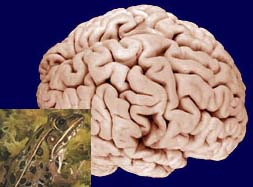
Biology
202
Neurobiology and Behavior
Spring 2006
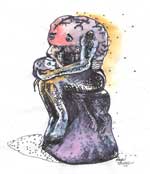

| Biology
202 | 
|
The challenge in general
Review of Blink, NY Times Book Review, 16 January, 2005
The response in general
| Biology major? | 18 |
| Psychology major? | 4 |
| NBS concentrator? | 7 |
| Other majors | English (7), Sociology (5), History (3), Linguistics (2), Philosophy, Russian, Creative Writing |
| Undecided | 3 |
| Satisfy science requirement | 5 |
| Interested in biology/nervous system? | a lot |
| Interested in psychology/behavior? | less than a lot |
| Interested in philosophy/nature of reality/human experience? | less than less than a lot |
| Interested in practical problems? medicine, psychiatry, social activism, etc? | more than a lot |
| Want to understand who you are? why you/other people behave the way you/they do? What you/they can do about it? | more than a lot |
Neurobiology and BEHAVIOR ... what is "behavior"?
NEUROBIOLOGY and behavior ... Neurobiology = study of the nervous system ... what is the "nervous system"?
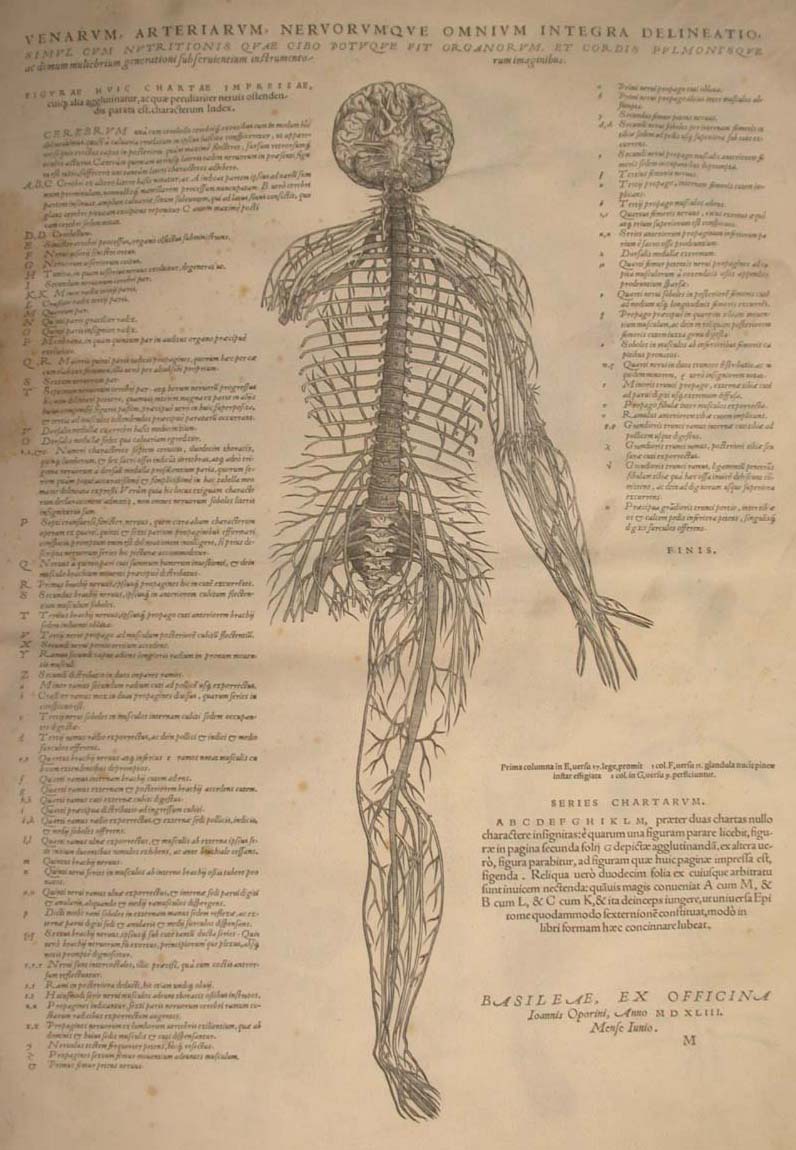
| Image by Andreas Vesalius (1514-1564), contemporary of Copernicus, suggested (less than 500 years ago) that nervous system rather than heart was origin of behavior (see Milestones in Neuroscience Research for a time line extending from 4,000 B.C.). | 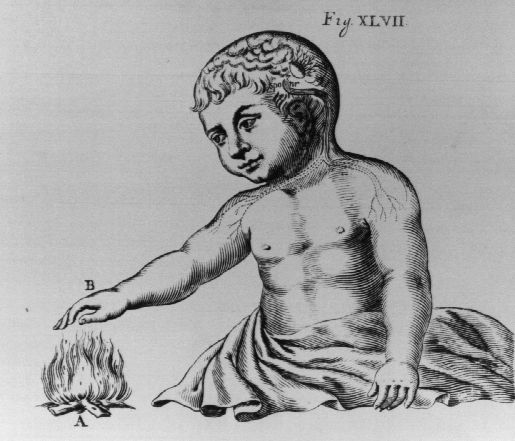
| Image by Rene Descartes (1596-1650). Set framework for several centuries (and continuing) discussion: mind and body distinct things or same thing? |
| Nervous system is material object, part of body, can be touched, manipulated, measured. What IS the relationship between brain (nervous system) and behavior (broadly defined to include human experience)? Subset of this are questions such as the relation between mind and brain, mind and body, matter and spirit, matter and form ... | |||
| Agree with Dickinson et al. | 3 |
| Disagree with Dickinson et al. | 14 |
| Unsure/fence-sitting | the rest |
|
(for future consideration) Are the brain and the spinal cord fundamentally different or elements of one larger system that have comparable degrees of sophistication? If a tree falls in the forest and their is no one there to hear it, does it make a sound? "what about organisms that don't have brains? Do they exist without a brain? ... what about organisms that do have brains? Do their brains have the same capacity as human brains to be "wider than the sky"?" ... Carolyn D. "Why is it, then, that some people are more able to control their behavior than others? ... Could brain equals behavior a little more in some of us than in others?" .... Claude "is [Dickinson] saying that since god can be contained in the brain, there is no god without the brain? just like the sky? ... Em |
Issue is not "Truth" but whether there is a good "summary of observations", "working hypothesis", something that contributes to getting it continually "less wrong" is useful for the ongoing generation of new stories in science and in culture at large ...
Start with overview of the "trend of the evidence":
|
(for future consideration) How do "eating disorders" relate to the brain=behavior idea? Are they "mental illness" or "mistakes"? Is "self-awareness" part of brain? What is the relation of brain=behavior idea to "inside/outside"? Doesn't behavior depend on what is "outside" as well as on what is "inside"? |
Our task for the semester (and beyond?):
Let's roll ... Forum area this weekend: YOUR thoughts on "brain=behavior", on science, on ... ?
Starting with what one thinks .... and getting used to/seeing the advantages of being wrong
|
The nature of science Is everything a science, in a way? ... Emily L. (see also Rebecca and Anne-Marie and Nancy) sometimes theory (heroically) precedes observations ... Brooks It requires some sort of training and experience in order to actually be a scientific thinker ... Andrea is nothing really certain? ... Lori Human history, therefore, could be seen as a series of hypotheses and then a whole lot of waiting around to see whether or not later events support or go against those hypotheses ... Brittany The definition of behavior I am quite dissatisfied with our current definition of "behavior;" it seems lazy to dump every option we can think of into one category, especially considering traditional bio. definitions of behavior. I am looking forward to improving/exploring it as the semester progresses ... Julia I feel that behavior has to be explored in terms what the brain thinks is going on as well as what is actually happening. Saying that a stimulus is being applied is doesn't help us understand behavior unless the brain thinks/knows that a stimulus is being applied ... Caroline Brain=behavior? is she [Dickinson] saying that since god can be contained in the brain, there is no god without the brain? just like the sky? ... Em Is the brain really all that stands between us and oblivion? ... The belief that there is some greater force "out there" is comforting. ... Tamara (see also Trinh) If human brain is arguably one (or one of the few) things in the universe capable of thinking about itself, why don't we give some weight to its self-reflections, as well as to the 'hard' observable data? ... Mariya ideas cannot be ignored as part of the scientific process ... Scott what about organisms that don't have brains? ... what about [other] organisms that do have brains? Do their brains have the same capacity as human brains to be 'wider than the sky'? ... Carolyn (see also Jen and Nicky and "The Animal Self") such an arrangement would lead to a rather reactive behavior - all behavior would be reacting to the world based upon previous reactions ... Astra It is difficult to explain the inconsistencies that exist in different people's behavior ... Could brain equals behavior a little more in some of us than in others? ... Claude Why is the brain so sensative to chemical dependancy to alter behaviors? Can you as a person override the chemical tendencies towards a certain behavior, maybe induced by environmental chemical stimuli? ... Danielle (see also Sylvia) Can we allow for experiences (in childhood, or even beyond) that impact and continually alter chemical levels? ... Courtney Behaviors like exercising, causing the release of the endorphins, or drinking alcohol, or doing drugs, all change the brain's chemistry ... Brom What then is causing someone to malinger if it's not their brain? ... Rachel what exactly constitutes a thought? If, as Astra said, cognitive behavior consists of a process involving neurons and synapses, can reflexes and other such unconscious movements be included in the act of thinking? Is a Freudian slip merely a 'mistake' that a neuron made or is it something more? ... Perrin there are many people who have eating disorders who clearly do not have tumors. So what exactly is going on? Different changes in the brain are leading to the same behavior ... Fatu if there is only the brain what made the brain the way it is? ... There would have to be outside elements ... yes, I know the world is viewed different for everyone and the way one perceives the sky or the earth or the universe for that matter varies as well but I feel each persons understanding of those things are basically the same. Lastly, if there is only the brain then what the mind is, is it just created by the brain as well? ... Whitney maybe things exist without us, but they don't exist in the same way. I have often wondered if people perceive things the same way that I do ... Amber things such as language (and perception), the behavior, are influenced by what people are taught culturally, not by physical features within the brain ... Claude what about the act of dreaming? ... I would like to think my dreams have meaning, but what if my dreams are just delusions and distortions of reality? How does my brain enable my mind to play tricks on me? ... Ebony But when we do finally see where everything originates in the brain, then what? Are we ultimately going to try to alter the brain and make everyone identical? ... Gray a better definition needs to exist between brain and the rest of the nervous system and how this unit correlates to behavior. Do we want to simply look at them as one unit, that generate behavior together or look at the interaction of units and see how that impacts behavior? ... Liz |
IF Emily is right:
How do we THINK the nervous system works, and how DOES the nervous system work? ... (What else must it be like if Emily et al
right)? ...
and a starting case, the cricket (Bentley and
Hoy, 1974)
Some starting points: a sphagetti bowl?
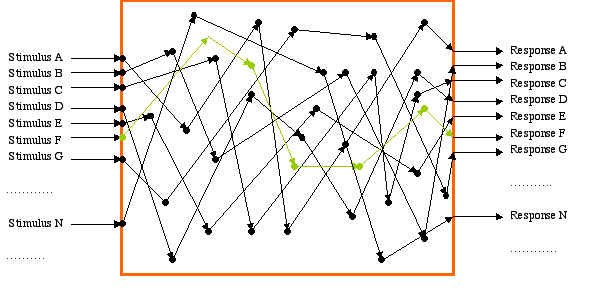
| Virtues
|
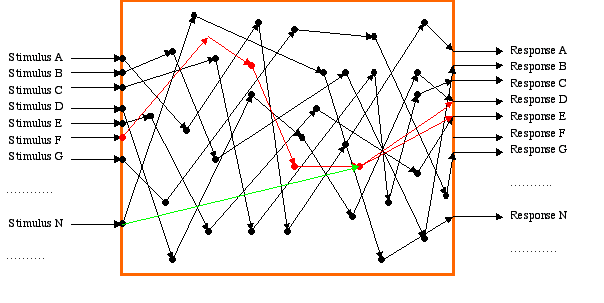
| Virtues
|
A rethinking - boxes in boxes
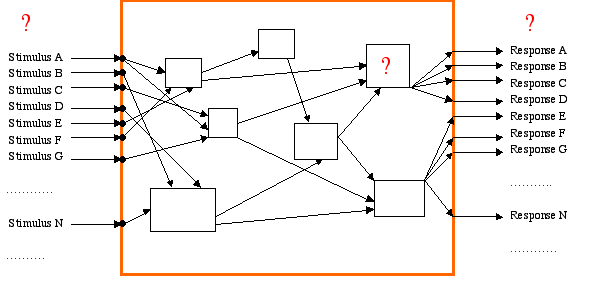
| Virtues
|
Facing up to the stereotopy, stimulus-response problem ... freeing the box from the outside world, adding autonomy
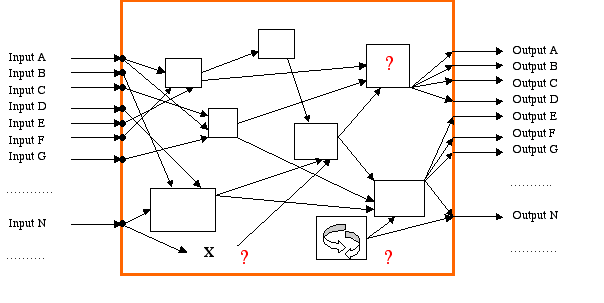
| Virtues
|
If brain=behavior then the nervous system must not be a stimulus/response machine (nor a bag of chemicals that is invariant and the same in everyone. It must instead be somewhat different in different individuals, be affected by both genes and experiences/culture, and be capable of different outputs for the same input as well as generating outputs with no input .... an input/output box consisting of input/output boxes.
|
(for future consideration) Do we want/need a demarcation between withdrawing one's hand from a flame and dreaming? Why or why not? If so, how should we make it in terms of the nervous system? Is there a distinction, in terms of the nervous system between "good" and "bad" behavior? If "personal experience" is a necessary component of observations relevant to understanding the nervous system, how do we deal with its being "private", "subjective", not accessible for public observation/confirmation? What is "private", "public", "subjective", "objective" in terms of the nervous system? Is science "progressive"? Are the humanities, literature, art? Life? What is "progress" in terms of the nervous system? from the news A Shocker: Partisan Thought is Unconscious This is Your Brain on Schadenfruede. Do You Feel Bad About Feeling Good? |
Go on to look at actual nervous systems to see if they satisfy expectations and to
address issues ... further iterations ("getting it less wrong") to come?
The "real" nervous system - an input/output box consisting of interconnected input/output boxes?

| 
|
| photo from Kemali and Braitenberg, Atlas of the Frog Brain, Springer-Verlag, 1969 |
Each box in turn (somewhat arbitrarily) subdividable into smaller boxes (with some differences among vertebrates, to return to)
And those ... yes, "its boxes all the way down"
The smallest box: neurons everywhere
Invertebrate nervous systems also have neurons, but differently arranged - makes sense?
Neuron as common, smallest box and as input/output element, connected to other boxes
Can use boxes->boxes ... ->boxes(neurons) to show that larger boxes interconnected, in relatively specific ways (anatomical specificity) and to rigorously specify "input" and "outputs" of largest box ... nervous system itself
So ... at least parts of our box within box model real ...
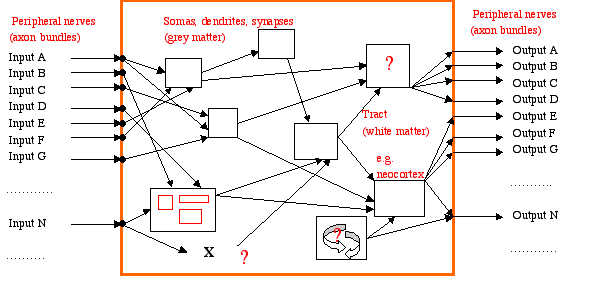
| Additions:
|
|
(for future consideration) Lots of neurons, therefore lots of room, both for individual variation and for things going on in there If consciousness is "inside", where is what one is conscious of? And what does "outside" or "inside" mean in terms of the nervous system? (as opposed to from the perspective of an observer of the nervous system?) |
|
Science I don't agree with the idea that the scientific method does not apply to life because of a lack of progress ... the person participating in self-destructive behavior, such as alcohol or drug abuse is constantly observing the effects this behavior has on them and their lives and making the choice to continue doing it so they are still using the scientific method to get to that conclusion ... Rachel M. (see also Jen) Brain = Behavior? Plants exhibit behaviors such as reproduction and growth, but plants aren't able to experience Schadenfreude like us. I think this calls for a demarkation between the types of actions organisms exhibit as a result of thinking (even if we don't realize we're thinking) versus actions that are purely a result of a response to an "input" or stimulus ... Ebony (see also Anne-Marie)
I agree with Rachel F... how exactly do you account for behavior that has nothing to do with the brain or malfunctions of the brain? ... Sylvia I think the Harvard Law of Animal Behaviour is a rather mundane and silly discovery ... It's rather presumptuous to presume that animals will react any differently from humans when stimuli are introduced. There is always a choice when it comes to what behaviour will be expressed by one affected by a stimulus ... [the female cricket's brain will always show that she has heard and recognized this chirp. The second part of this behaviour, the outside manifestation, does not have to always be the same. She can react in may different ways externally, but the brain chemical reactions will always be the same ... Tamara Nature/nurture So then is this a nature/nurture thing, where we are given a brain that is genetically formed one way, but the way that we are raised and the experiences we have can change/form our personality? Does that then mean that these experiences actually physically change the way the brain works, in order to change our behavior? ... Marissa (see also Caroline and Astra and Stephanie and Danielle and Claude and Christin) Now that I think about it, conditioning has a very big effect on everyone's behavior. How does it really work? Like biologically, at a neuron level? ... Emily L. (see also Brittany) think about all those possible boxes and all those possible combinations! how could there possibly be one set-up for males and one set-up for females?? there must be nearly infinite variations on gender with all those permutations ... Em (see also Does Biology Have Anything to Contribute to Thinking About Sex and Gender?") The "unobservable"? how does intuition fit into the brain=behavior proposal? How can we explain/describe the sometimes irrational "hunches" and bold guesses, which often lead to break-through discoveries, in terms of interactions within the brain? What about the fact that scientists literally make discoveries in their dreams? Do they arise from the interplay between the "conscious" and "unconscious" boxes within the nervous system? Actually, do we still want to think in terms of "conscious" and "unconscious" in this class? ... Mariya these unobservable behaviors may pave the way for new hypotheses and future research; they could very well be considered "undeniable fact" in 50 years ... Andrea I was thinking about how the neocortex interacts with the rest of the nervous system. If the neocortex is our consiocusness, then that is all that matters to our interpretation of the world. If we could create the correct stimulation to it, we would sense a world that isn't there in a sense. So what do this power to override do to the rest of the boxes. Maybe nothing. But I wonder if all that matters is this box and what its percieves inputs are, regardless of what the actual inputs to the other parts of the nervous system are ... Liz P. Brain=behavior and cultural values I enjoyed Gray's posting challenging the aim of mapping the brain, and, it seemed, offering a word of caution against the potential homogenizing effects of identifying a "standard" for neurochemistry, and I wonder if this isn't the aim of many such medications - enforcing a standardized ideal of mental health or "happiness" ... Courtney (see also Bethany and Paul and "medical model" vs "biological/neurobiological model" and Culture as Disability) Drug A doesnt always produce result A on everyone since everyone is very different. Psychiatrist and psychoanalyst should explore talk therapy as an alternative or complementary remedy to psychological conditions, because just as behavior is influenced by the chemicals in the brain, the brain can be influenced by behavior to make chemicals to affect itself ... Trinh |
Invertebrate nervous systems also have neurons, but differently arranged in detail, same principles - makes sense?
Continue looking at actual nervous systems to see if they satisfy expectations and to address issues ... further iterations ("getting it less wrong") to come?
The "real" nervous system - different if behavior different?
Outputs - topographic organization - anatomical specificity
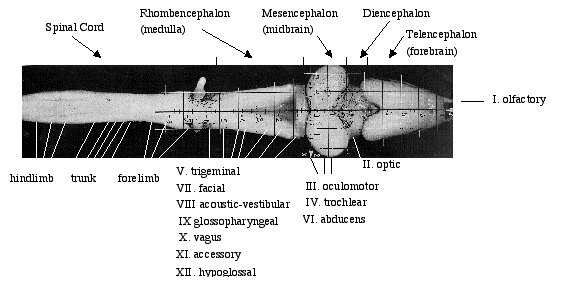
| For additional information: |
Observations "surprising", but have to be accepted - Issue is "how to make sense of them"
Two kinds of behavior ("reflex" versus something-else) intuition probably not useful
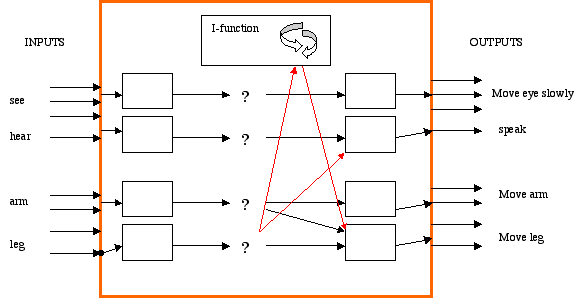
| Ascending somatosensory
pathways Descending motor pathways
|
|
Science I walked into this course with the prejudice that neurobiological theory as it stands is "wrong" and that therefore it is only useful insofar as I can learn something by demonstrating its fallaciousness ... regardless of what is currently measurable the systems methodology relies heavily on constructs to fill empirical gaps in the explanation of behavior. This means that the cutting edge of neurobiology will always rely on theory to be one step ahead of observations. Because the paradigm is very theory dependent, you should not be fooled by its pretension to an objective empirical grounding ... Brooks
Brain = Behavior? If we can show that certain behaviors that people exhibit are biologically based, they may make no effort to control these behaviors ... Claude If choice is just a random pattern in a certain box in the nervous system what initiates that pattern? Is there any way of changing the brains structure that would change an individual's choice? And is this measurable? ... Whitney the best outcome for patients is often reached through a combination of western scientific approaches and eastern holistic approaches. If it works, it works, but it would be nice to have a better grasp on how to get from point A to B so we could use both types of treatment to maximize patient care/recovery. Our lack of understanding lies in our vast ignorance of brain and body function ... Julia P.
Language When we listen to someone speaking, do the same neurons fire as those that would if we were saying what they are saying themselves? What about sign language? ... Bethany I think we fire different neurons when speaking and listening because they are two separate actions .... Christin The comments about native language versus a non-native language that is learned past a certain age are interesting. Is it that different neurons are firing or that it is the same neurons, but that they are arranged in a different pattern? Is it like the metaphor with music that we discussed in class where different patterns of the various instruments make different symphonies? ... Anna ... also (Suzanne, Bethany) It is interesting that someone else has raised this question because lately I have been very conscious of almost translating when I am listening to other people talk ... I first noticed this last semester when I was taking a Spanish class that was much more intensive than any I had taken before. As the semester progressed I noticed that the kind of translation I had to do in my mind was different from just pairing the Spanish word with the English word but instead kind of processing the Spanish word ... it's a long way of saying that I do think that we have to "fire" the same neurons when we read or listen to words that we would have to fire if we were saying them ... Nicky
Quadriplegia When we were first discussing Christopher Reeve's injury I was surprised to find that when his toe is pinched, his foot will withdraw. I originally thought that he wasn't able to move anything below his waist ... I realized afterwards that doctors simulate this same phenomenon when they give patients a spinal block. I happened to have received one when I had my knee operated on in October. After I woke up from surgery, I had no feeling below my waist allowing me to experience no pain, but when the doctor made my quad muscles contract, they did. ... Rachel F. (see also Stephanie) People who have had strokes sometimes retain "self" but sometimes do not ... Marissa It reminds me of people who snore and tell you "I don't snore". Their body is clearly doing something others percieve but there isn't an easy way to make them know that. To the self they did not do this ... Liz as a massage therapist, I've found that so much of the "self" can and should be defined beyond the rational thinking being ... Courtney reminded me a lot of another question that came up in class ... the infamous "if a tree falls in a forest does it make a sound?" ... This situation can be applied to a paralyzed person such as Christopher Reeves. When his foot is pinched, it draws back. Sensory neurons have relayed a pain message to the lower spinal cord and the spinal cord has induced motor neurons to move the foot but does the lower spinal cord *feel* pain? The rostral part of Christopher Reeves brain can verbally report sensations of pain, but the severed/separated caudal part of his brain cannot yet it still reacts ... so, is it capable of feeling pain? ... Carolyn
"I" does not simply mean the thinking, experiencing, and self-reflecting "I"", but the whole set of our behaviors, conscious or unconscious. I actually liked that understanding a lot because it was a way to resolve the mind/body dilemma by including the body, the conscious, and the unconscious into our definition of "I". I wonder whether this still holds true. If the "I-function" is located only somewhere "above the shoulders," wouldn't it send us back to the Cartesian split, at least in some sense? ... Mariya It would be interesting to examine the brain of someone with trauma induced "paralysis," blindness, or deafness to understand which parts of the nervous system are affected, if any... (i.e. how regions of the brain may appear different in one with hysterical blindness vs. one who is born blind.) ... Ebony If there were to be a brain transplantation between your physical being and another's, where will "you" be? ... Jen isn't it all together possibly that there are further levels of organization that extend beyond the boundaries of the brain to encompass the whole body, or even the whole environment? ... Astra
|

From Christopher Reeves
|
The "I-function"
|
If its all sensory neurons, motoneurons, interneurons, and signals moving among them, we need to look at signals, what they are, how they're handled ...
Signals:
Action potential - longitudinal battery which appears/disappears successively at successive points along an axon ("travels" at finite speed), "all or nothing" transient (millisecond range) event
To understand action potential, need first to understand resting potential - transverse battery, continuously present, with potential for continuous variation
|
Equating "self" with "brain" fails to acknowledge the extent to which we are reliant on our bodies for our selves, and the ways in which our non-nervous systems constitute the self. The classic philosophical example is the "brain in the vat." If the brain is the self, this entity should be a self, also, right? But without a body to provide input, the brain is useless - it doesn't even know that it is a self, or how to define that self without the ability to relate itself to the surrounding world ... Courtney This weekend, I broke my ankle. Granted the injury was to a region of my body far from my brain, my behavior has certainly been altered. I have to learn how to multi task with crutches and do homework with my leg elevated in bed. If brain = behavior, is it valid to say that my broken bones have had an impact on my brain in such a way so as to influence a change my in behavior? Or is this change in my behavior brought on by something separate from my brain? ... Ebony We are being asked to reject the Cartesian notion that the self is so high that it floats above the body, but in our own model we might hypothesize that the self is still the "highest" that you can get within the nervous system. Highness needs to have a meaning, and I think this notion of the highness of the self has something to do with the presumption that our egos are more or less in control of our behavior ... perhaps the self [mistyped as "brain"] receives commands--which it must obey--from a higher authority that has already processed information outside of the I-function ... Maybe pain is a higher, more primitive source of decision making that is located outside of the I-function. Or maybe pain is a remote control built inside of the I-function to be exploited by some nefarious stranger ... Brooks
In my mind, stimuli affects the brain, which affects behavior. It's a linear progression ... Julia I don't think that I see the self as being the highest box but rather the limit of perception. We can say that other parts of our body impact our mind ... However the question always lingers in my mind of whether those things that I think are happening are actually happening ... I keep coming back to this idea of whether or not there is anything here but my consicousness and my perception. ... from being a martial artist one thing that you learn to do is shut off pain. A choice by my conscious mind is now impacting my perception of the world around me. I don't really know how to rationalize that but I just think that looking from the opposite side (the mind's impact on the perception of physical body not the body's impact on the mind) is interesting. I was always amazed when reading those faith healing stories and I wondered if the power of the conscious brain could really change the physical form ... Liz
I was able to experiece the workings of propioception when I learned how to walk downstairs again after I had knee surgery. The muscles I use to walk downstairs were unused for almost 3 months. As my physical therapist and I tried to go through the motions of walking down a stair, my knee didn't know how to bend (it was as if the muscles were asleep). What helped me was watching him make the motion and then visualize making the muscles in my knee bend ... Rachel F. ... reminded me of how astronauts have to learn how to walk after traveling in space ... By watching others walk, our brains can register the information and, in turn, remember how walking feels. By watching others perform an action, our brains are able to understand how they are doing it, and can help us to mimic them ... Stephanie ... fascinating, particularly the idea that the "conscious portion of the nervous system relies on the "unconscious" portion for all information, which leads me to wonder what happens when the "unconscious" portion interprets the signal incorrectly. I hope we cover that in more depth later in the course ... Anne-Marie I am curious about why certain signals seem to "get through" to our brain, whereas others are ignored ... "cocktail effect" occurs when you are having a conversation while many other conversations are occuring around you. Although you tune out the other conversations and pay attention only to your own, as soon as you hear a stimulus (such as your name), your attention is directed to the conversation you had been ignoring up until that point. The question is: have you been ignoring it the whole time or have you been processing it in some other "box" other than your I-function? ... ADD? ... Many people have difficulty concentrating at some point in their lives or in certain situations. I wonder what causes us to sometimes be able to control the signals that get through to our I-function but other times, be helpless to distractions ... Rachel (also Danielle) When our desires or urges are shooting off signals for us to act to satisfy them, there must be another part in the brain that reconsiders this desire and the consequences of acting on it. Then when a decision of inaction is made, are the signals from the urges then ignored? Can the urges eventually be trained by the part that makes this decision to simply stop? To what extent can we control our involuntary desires or more specifically our awareness of them. Can we be our own anesthetics? Can we make ourselves not perceive pain, hunger, thirst or sexual arousal ... Trinh The Self and the I-function really are extremely fluid. In her memoir _Where Is the Mango Princess?_, Cathy Crimmins discusses her husband Alan's extreme personality changes after his TBI (traumatic brain injury) ... Christin how many boxes are in this box? ... Sylvia if we could say that the I-function itself were not an impenetrable box but rather just as fluid and multi-faceted as any other of the boxes we've talked about, i'd be very happy ... Em (see also Andrea and Jen) I think I would even go on to say that in talking about identity scientific progress can no longer claim that it is getting the story less wrong, but as new stories are told new realities are created--the truth about the i-function does not exist beyond somewhere, it exists differently all the time, in the now, and in the process of re-describing it ... Scott
I have heard that when under the influence of certain drugs one could "see" music or "taste" colors. Upon doing a little research I discovered that people who were not on drugs experienced this phenomenon, it is called synaesthesia ... Brom mirror neurons and ... where they might fit ... Since these neurons have both motor and sensory functions, where would they go in our box model? ... It was also amazing to me how specific these neurons are--for example, different neurons in this region fire for different ways of grasping objects, if the same motion is carried out without the object, and they do not fire if the action isn't goal-oriented or if the person uses a tool to grasp the object instead of their hand. Can all of our neurons really be this specific? If there area as many neurons as stars in the milky way galaxy I guess they can. And what defines a "goal-oriented" action in our brain? ... Gray since the size of an action potential is constant, it is the frequency of the action potential that creates variation in the strength of an input we receive. If this is the case, why do we have individual variation in how we perceive constant things? ... Claude When we were first discussing the action potential, to help explain it, several analogies were put forth (such as a traveling battery). I thought the transmission of a signal down the axon reminded me most of the Maglev trains. ... The idea is that the tail of the train is of similar polarization to the track behind it while the head of the train is of opposite polarization as the track in front of it, causing a push from the back and a pull from the front. ... The thing I don't get is why a more advanced system didn't develop. Obviously, having reaction times of a second or more is extremely slow and potentially dangerous. Why couldn't a system develop more like that with electrical lines that run through the wall from a light switch to a light bulb in the ceiling? Isn't the brain an organized "electrical storm"? ... Jessica E. what would happen if there was either a deficiency or an over abundance in one of the ions necessary for the pump. Could it result in an action potential inadvertently being created? ... Anne-Marie |
If its all signal processing, have to understand signals ...
ONE signal in the cables, the action potential ...
To understand action potential, need first to understand resting potential - transverse battery, continuously present, with potential for continuous variation
action potential: adjacent membrane regions with different transverse batteries (because of different selective permeabilities) - Issue then is how to get it to MOVE, with finite velocity?
Notice it is NOT matter moving, nor energy, it is a perturbation (signal, information)
|
I was watching The Royal Tenenbaums the other day, and my favorite part of the entire movie, when Owen Wilson says, "...and they rode off into the friscalating dusklight", got me thinking about action potentials. Friscalating wasn't a word before this movie came out, and yet, (just like Shakespeare!) in the context of the passage, viewers understand what the word is supposed to mean ... Isn't it incredible that the brain can interpret and derive meaning from the infinite amount of combinations of action potentials down axons?! Even action potential patterns that it hasn't ever dealt with before! ... Rebecca
action = motor symphony = pattern of output signals = pattern of action potentials thinking = ? feeling = ? |
Will propagate if started. How affect things? How started? Need to understand synaptic potentials, receptor potentials, but first ...
Lots of things can start it. Among them is something that provides answer to one of our box questions ...

And the big question ... Do signals actually start in the middle of the box? If so, how?
Yes, not mysterious, follows from what we know, if we add possibility of some differences in permeability of some membrane regions not mysterious, has interesting implications ...
Go on to receptor potentials, synaptic potentials (how action potentials affect things, how boxes integrate, how signals stopped in box)
Input (sensory) signals - an example
|
Action potential and membrane permeability seem too structured/limited to describe all possible brain function...the same process applies to moving one's leg and to philosophy and to love? ... Julia P. perhaps I am underestimating the power of the brain ... Ebony
I am interested in the distinction between the conscious and the unconscious mind. I have a sense that sometimes the two (although "the two" implies a clear barrier, which may not be the best way to characterize the distinction) fight one another, for example when we have a desire for something like food ... Brittany In some ways, I think that gesturing is kind of like the brain's own language ... like the brain is joining in on a conversation ... I am still mulling things over, but I am curious about other behaviors that the brain supplements seemingly independent of the "I function" ... Carolyn D
what causes the initial action potential that drives all the others? Does the idea of the I-function have something to do with it? For example, does my arm move because the I-function, or the self, wants it to move? ... Fatu when I make the decision to either ignore my physical pain and continue or to accept it and stop, is my brain producing a different pattern of action potentials or different action potentials all together? ... Jen People who enjoy experiencing pain (compulsive cutters, those who pierce their flesh with hooks) also say that extreme pain is a release and brings them to another level of consciousness that because of pain they are able to tap into their unconsciousness ... Christin the important part is "self-inflicted"--I would think that if they broke their arm or stepped on a nail they would still feel pain, perhaps because they werent in control of it? ... Marissa
how is it that some people are able to control their hallucinations and others are not? Furthermore, how is it that some people are able to rationally explain that what they are seeing doesn't make sense and therefore, it can not be real while others are not able to differentiate between the two because both are a pattern of action potentials? ... Anna why do some places just "feel creepy"? Is it because we have learned to associate certain aspects of these places with "creepiness", or is it actually something about the place that gives off something our sensory receptors pick up and we then "feel"? ... Tamara "how do we come to know things we do not have receptors for?" could it be that those boxes that create signals with in them shape perception of things we have no senses for. Could it be that some reaction created in a box; within the brain help to formulate our individual ideas about religion and higher powers? ... Whitney In the former Soviet Union, solitary confinement and imprisonment of absolutely sane people in mental institutions were "normal" means of governing. Most people who went through these experiences of complete isolation (and even of literally being deprived of motion) ended up like the subjects in PG's story, except that their schizophrenia-like symptoms did not go away in time ... Many religious people went through these experiences, and there are some studies in Russia now that suggest that these religious people were much more likely to remain sane ... When they were asked what helped them, they answered "prayer" ... If by prayer we mean an encounter/conversation with something Other than ourselves, and if that Other does not depend or is not akin to normal sensory inputs, then it would make sense why the I-function didn't go bezerk in the absence of signals from the outside. It was receiving them, but not from "conventional" sources ... Mariya
I am curious as to how the neural impulse creates orgasms. Are orgasms just a serious of action potentials? One action potential? ... I am wondering why women can have multiple repeated orgasms and men are less likely to be able to experience this phenomenon. Would this mean that the time during which the nerve membrane is impermeable to sodium is shorter in women? If so, does that hold in other parts of the body? ... Claude And let's get on this topic of orgasms. Is that a sensory or a motor phenomenon? ... Brooks not just individual signals, but patterns of action potentials can occur spontaneously--and I am very hesitant to believe this ... Gray In humans, walking and chewing are examples of rhythmic motions caused by a CPG ... Rachel F
I think to some extent it has to be possible for signals to start in the box, as we sometime have thougths that pop into our heads ... It seems possible that every once in a while a convergence of potentials could become high enough to set off an action potential that would trigger some thought depending on where in the brain this all occured. In some ways, though neither of these (the message finally getting through or the randomly generated action potential) are completely independent of what's going on outside the brain ... Erin We all "think" before we "say", or so we are taught. If words, thinking and feelings are all action potentials, then what controls our ability to have "control" over these action potentials? ... Stephanie If a feeling, for instance, is the result of a pattern of action potentials, then when we suppress feelings are we blocking the action potential from continuing or was there never an action potential to begin with? If these patterns of action potentials can be changed or suppressed, how do they "stop" within the body to prevent further response? ... Danielle
I do know that at the dendrites (receiving end) of the neurons, both inhibitory and excitatory AP's are recieved, but only one type of AP is sent out - which implies some sort of processing of signals from all over the brain ... if action potentials can start in the middle of our system, it makes sense to me that they can stop in the middle. I find that thought provoking in terms of what we see and react to ... Astra I think that we are thinking about macroscopic concepts, such as feeling, but looking at microscopic structure. Maybe we need to zoom out a bit and look at bigger structures ... Caroline |
Spontaneous action potentials and receptor potentials - a box that not only receives and emits signals but creates signals itself. Problems?
|
Reminders about receptor potentials and implications:
|
Can we rephrase this week's forum questions in terms of various patterns of activity at various places in the nervous system? If we add in inhibition? Do we sometimes "act before we think"? What does that mean in terms of various patterns etc.? Do we react to things before our "mind makes up a story about them" (as when dreaming and an input becomes a part of the dream)? What does that mean etc? "Creepy feelings"?
|
Synaptic potentials - Synaptic integration
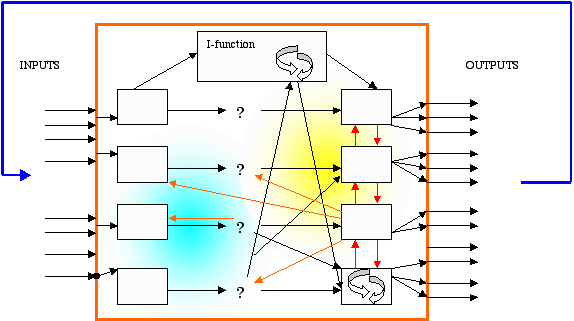
Seeing where we were, where we are ...

Problems solved, new issues raised ...
Moving on ... from "microscopic structure" (building blocks) toward bigger assemblies ...
Behavior
|
This made me wonder how useful it is to talk about our sensations and behaviors in terms of patterns of action potentials when nobody can really read/speak the language of action potentials (well, except for our neurons). To say that smiling, or tasting a sandwich or stubbing your toe ... is a pattern of action potentials oversimplifies these events. I can accept that action potentials trigger/mediate/modulate all brain events and I think that studying them is interesting and important ... but I don't want to miss the big picture. (Like looking at a Seurat painting from an inch away instead of from across the room) ... Carolyn I'm not sure I agree with the idea that we are unable to read the "language" of action potentials. I have been learning in another biology class about swimming in leeches. We stimulate the leech nervous system, and then watch as, on a computer screen, complex electronic equipment interprets electrical signals into a recognizable pattern. This pattern, whenever it shows up on a graph of leech nervous system potentials, signifies that the leech is swimming - even if all that remains of the leech is the nervous system - the body has been completely removed. This extremly recognizable pattern, i would say, is the "language" of the action potentials ... Carolyn The fact that the nervous system has the power to change itself is one of the most fascinating things I have learned so far in this class ... Andrew
Is there some kind of preemptive "thinking" going on inside the neuron. It seems that if the neuron modifies the signal, it must have some "understanding" of what kind of response the AP will ilicit. How is this possible? How then can the nervous system respond appropriately or coherently to completely new AP patterns? ... Rebecca I think the idea that most of what the nervous system does is inhibition very interesting. On a larger scale, is that what makes all kind of personalities different-exactly what we refrain from doing? ... As an infant/toddler you have to learn how to do all kinds of things-walk, make sounds, focus your eyes, etc. How much of that is inhibition-driven? How closely related is the inhibition of the running action potential pattern in chickens to human social inhibitions? ... Erin The case of the surgeon with Tourette's got me thinking about good ole action potentials. I thought maybe the part of the brain responsible for dealing with the action potentials involved in Tourettes was the same as those involved in surgery. I am not sure how this would work but if it were the same neural pathways necessary for both it seems possible that one action would trump the other ... Brom would this mean then that other people who have their tourettes "turned off" by, say, riding horses or baking have different pathways of action potentials than the man from the book? Then perhaps their symptoms are a result of completely different mental processes that somehow cause the same result? ... Marissa Yesterday, while studying for italian, I suddenly became aware that my sweater was itchy around my neck. I had been wearing the same sweater all day and so it had obviously been itchy all day, yet it wasn't until that moment that I felt uncomfortable. Thinking about this in terms of this class, I believe that my body probably felt the discomfort (and sent signals "about it") but because there was other stimuli that was more important at the moment, the signals were ignored. The random signal finally got through while I was studying because, perhaps, the signals that should have been perceived (italian) were boring. This leads me to question whether anything is ever really random ... Rachel I understand that the more one does something the more one can do it again--the process of engraining or conditioning is based on pattern recognition and replication. Is there a way to heighten the mind to patterns that are less 'visible' or straightforward to the five senses ... the world is always ripe with newer patterns and newer ways of perceiving it, which is why the meticulous deconstruction of nature (science) is only one story of getting one type of seeing less wrong ... ... Scott
how do we seperate the cognitive behaviors, such as thought or emotion, from the physical aspects of behavior, such as moving your hand? ... Is it the physical aspect of motion (such as smiling and then feeling happier), or is it the internal discussion that leads to a physical manifestation (frowning when confused) ... Caroline When do emotions stop being a choice and start being a function of our behavior (or the state of our brain)? Can some emotions be embedded in us/instinct? ... Ebony Isn't it interesting to think that such a complex emotional response as love is created by a hormone? ... Christin What if different people trigger different amounts of oxytocin and/or different mixes of other, related chemicals in our brain, and it's these various mixes that determine how we feel about each person...and a particular mix makes them our "special someone"? This mix is partially based on physical characteristics (what we first see), but also on what we know about the person, and so it can change over time ... If there are infinitely various brain setups, then there are infinitely various ways to process attraction and love, with only one of the facets being the gender(s) one happens to be attracted to ... Brittany A lot of people have been talking about oxytocin. Not only is it vital in female relations to infants, but it is also thought to be vital in male attachments to females and male caring for infants ... I wonder if this creates the huge variety of behaviors and ways in which different people react differently to relationships ... Could we build the perfect monogamous mate? ... Liz P. One of the major differences between addicts and non-addicts is the sensitivity of an individual's dopamine receptors in the brain ... If the same neurochemical present in all of us is responsible for both metal illness and infrastructural personality traits, what does that mean? Are all of the emotional/psychological/mental manifestations of the brain (all a series of action potentials) merely a function of the same few neurochemcial transmissions? Is personality the same as mental illness (on a neurobiological level)? How unromantic! ... Julia P. I never thought of putting epilepsy and obesity in the same thought ... Suzanne The implications of the differences between the brain of a "normal" person and the brain of a killer could be astounding. I wonder if, in the future, we might be able to provide a drug treatment for the condition rather than just imprisoning the person who committed the crime ... Anne-Marie the question posed might be "what causes these emotions, what sets the "baseline" for them, and how is it that they can change over time and be influenced by environment?" ... Jessica E.
All patterns of activity? Where? How created? How controlled/controllable? ... PG
The Unconscious Mind: A Great Decision Maker ... The unconscious mind doesn't seem to be a part of the "I" function we have been talking about in class. Then what is it? Just a pattern of action potentials? From the evidence of this case study, it seems like the pattern of action potentials that go "undetected" by the "I" function are not totally random since the participants were able to make a sound decision when distracted. So, does this pattern of action potentials have a pre-determined course/pattern in the CNS? If so, how are they determined? Genetics? Memory? ... Jen I was thinking about the subject of rationality and what I recently learned in a cognitive science class. There's a phenomenon called "probability blindness" that prevents us from seeing certain odds and probably is why we're such bad gamblers. I thought about this in relation to things we don't pick up on, like the infrared stuff ... So then, what is math? Are there some sorts of math that we don't pick up on, or is math something we've made up to understand the world? ... Suzanne
In my Learning Theory and Behavior class, we look at learning from a behavior analysts' point of view. Therefore, according to my professor, learning affects the brain not the brain affects learning. How do I know which one is right? I can see where he is coming from, yet isn't the only way you are able to learn is through patterns of action potentials? Help! ... Rachel F.
|
|
Fundamental Limitations on the Effectiveness of Drug Therapy Behavior consists of complex patterns of activity across large numbers of neurons Chemicals influence but do not determine those patterns There is no one to one relationship between a chemical and a pattern A given behavior may correspond to any of a number of different patterns and a given pattern may itself have a number of different causes There is, in addition, an element of unpredictability in the generation of the patterns And an important bidirectional exchange between the unconscious and the "I-function" Therefore ...
|
Begin (non-traditionally) with output - "action" (since not all outputs can be accounted for by inputs)
|
Action = "motor symphony" A new concept: the reafferent loop Accounting for motor symphony
| 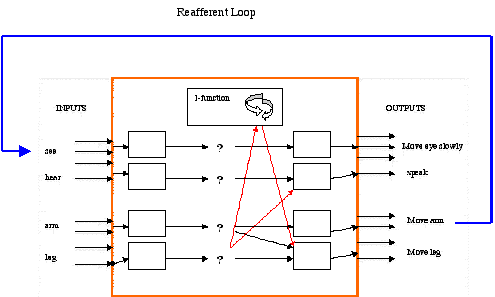
|
Preliminary human evidence?
Looking more closely at the "central pattern generation" hypothesis
Implications of earthworm case
|
When I was thinking about a signal starting "in the middle of a box", an example I thought of was that sometimes one can have a craving for a certain kind of food. However, I'm not sure that we can tell if a signal is starting on its own or if we simply don't understand the stimulus that causes it ... Nicky How do we really know that signals are starting in the middle of the box? Are they occurring beause of an outside input and we do not know about the receptors for it? ... ... Anna it has been clear for a long time that both nature and nurture influence behavior. However, recent studies of "achievement motivation" (i.e. ambition) in twins can give us a clearer picture of how much of one of the most common behaviors in the human experience is determined by experience and how much by genes. The experiments show that twins' motivational drive overlaps 30-50% with each other ... So it is clear that genes do strongly influence people's levels of ambition. However, from what we know so far, at least 50% of ambition is determined by experience, which indicates that experience probably has a larger effect than genes on our levels of ambition ... the writer of the Time article, Jeffrey Kluger, cites studies about immigration as evidence that ambition is largely determined by people's surroundings. He says that many immigrant children from collectivist societies like those in Asia and Latin America quickly adapt to the competitive American educational system and even outperform their peers. However, this is shaky evidence, because who is to say that people who immigrate from other countries do not have a greater presence of a certain gene that gives them the ambition to emigrate to new countries in the first place. Maybe those immigrant children were more successful than their peers in their homelands, too. Just a cautionary note about accepting as valid evidence everything we read about, even in a mainstream magazine like Time ... Andrew I've been skeptical of reductionist theories for a while, but I hadn't taken seriously the power of geneticist explanations in popular culture until I started reading my book for the semester. It's Human Natures: Genes Cultures and the Human Prospect by Paul R Ehrlich. The author is explicitly fighting what he considers to be the culturally dominant "reduce everything to genes" method of argumentation. Science is certainly the source of such popular notions, but I wonder, why are some scientific theories popularized and others not? .... I expect that much of the population variance in depression and ADHD can be explained with social structural variables without recourse to biological variables. Is anyone aware of studies that attempt to compare biological and social structural approaches to the explanation of depression? ... Liz P. I think that "knowing" is a term with too much grey area and I do not believe that children with ADHD or ADD are incapable of "knowing what it is too pay attention". I do, on the other hand, think that these children have disorganized/uncoordinated/underdeveloped neural pathways or motor schemes which make it more difficult for them to attend ... I think that people who feel like something is interfering with their abilities to function and lead healthy lives should have free access to services which would allow them to work through their problems ... I do not, however, believe that drug therapy is always the healthy or best solution. I think that our country has a stigma against talk therapy and that our aversion to talking through problems (whether it be with friends, family, or a psychologist/psychiatrist) has had a detrimental effect on our level of general mental health ... Carolyn I don't want to deny that there is a common structure of psychological illnesses, and that we are all human, and therefore have a tendency to similar problems, but I think that there is much too much effort to homogenize and "normalize" psychological health, to impose a single framework onto a variety of cases. This can be seen in "healthy" situations/society. Just walk around high schools in the US and read the posters on the walls. The "catchwords": be yourself, positive attitude, "you are a star", etc. are the same everywhere. From their earliest moments, American kids acquire a "pre-made" vocabulary, into which they squish their emotions and lives, be it the "prep-school" vocab or the "indie" vocab, or some other style. Of course, it facilitates communication and makes us feel less alone. But I think it largely erases individuality/personality ... Mariya |
Thinking about signals starting in the middle of the box
|
CPG from genome/experience/combination - is interconnected neurons
Location (back to crayfish)
Motor sympony lacks a conductor - coordinated performance of independent players (cf. Boids, flocking, fireflies) - efference copy = corollary discharge
Look at some more uses/implications of corollary discharge:
|
The explanation that signals can start in the middle of the box is very interesting and it helps to explain certain things, but Nicky brings up an interesting point ... How do we really know that signals are starting in the middle of the box? Are they occurring beause of an outside input and we do not know about the receptors for it? I don't know if we can get answers to those questions because if we are not aware of the receptors, then we have no way of proving it either way ... Anna
Which one of these controls our behavior? Do individuals differ in the relative importance of these two components? Where does "free will" fit in- is part or all of the I-function considered "free will?" The environment can influence genetic expression, but genes cannot change the environment. So is the external more important than the internal? And if, as Prof. Grobstein claims (and I agree), free will is purely an internal function of randomness and decision-making in the I-function, then is the environmanet irrelevant in relation to "free will?" ... Julia
It seems to me that free will in the philosophical sense, the ability to choose freely from a set of viable alternatives, does not really exist in the neurological sense. From a scientific perspective, it seems to me that one's environment and genetic makeup influence both unconscious and conscious brain activity. This implies that choosing freely isn't much of an option if we have been conditioned by factors in our environment or in our genetics to make certain choices. The question that still remains in my mind is whether actions based on instinct are condsidered choices and if they are how do our brains make a final decision? How did Dr. Grobstein's son as a toddler choose to roll up into a fetal position when he became aware that he was falling? ... Ebony
When someone swallows, they have conscious control over their throat muscles close to their mouths, but that motion actually continues all the way down to the stomach even though we cannot feel it or control it in any conscious way. At the time I assumed it was a sort of chain reaction, but now I wonder if it's a pattern generated elsewhere where we only know about the first part of the pattern because that's the only part where the feed back ends up in our consciousness ... Erin
It does not surprise me that once triggered, a certain chain reaction can occur. But I wouldn't call that a CENTRALly generated pattern. I realize that sometimes (as in the leech nervous system) the pattern can be generated on its own if you wait long enough. (I wonder how often and in what scenarios that occurs in humans.) But what about when we consciously trigger a pattern of action potentials like a memory, or decide to start running or pick up an object? How is that very first action potential started? I would say that "we" have the power to consciously move ions/start action potentials, but that just means that our brain/I-function has the power---but where?? ... Gray
I got the impression that we were working towards the idea that our brains have multiple pattern generators and that there is no master pattern generator. I was wondering were the "I function" fits into this idea. Is the "I function" a product of pattern generators or is a pattern generator itself? Also, if the "I function" is a pattern generator, wouldn't it be the master generator? ...
I was also wondering about the physical properties behind pattern generators. From our class discussion, I have somehow linked pattern generators with perpetual motion! I just don't see how it works without breaking some law of physics! How is it possible? ... Carolyn
Are different neurons firing depending on why one's taking the drug? How does the I-function differeniate between drugs taken for pain and drugs taken for "fun"? ... Rachel F.
It seems that we have been raised in a culture that suggests that one cannot miss what one never had, usually the argument for the noble savage and how "primitive" people are happier than "civilized" ones. But the idea that there is pain for a limb that does not exist opens many new possibilities. It means that we can miss that which we have never had, as we always new we could (example, coveting) ... Tamara (also Astra, Claude)
Why is it that after I make a choice to do something (eating), I can't stop the events that follow whereas if I make a choice to do something else (walk) I can stop the process (stop midstep)? What makes the two fundamentally different? ... Rebecca
I don't think two interacting pathways which produce seemingly different reactions to the same input are what is normally implied by choice. The model from the Pleurobranchea (sp?) is really a different outputs because of different combinations of inputs ... I suppose it's possible that what we think of as "choice" when given the same circumstances is really just a set of slightly different inputs that produce the different responses. But I think there is a sense that we feel ourselves making decisions, and not just in a way that could be explained by the set of interacting patterns and systems being made conscious ... Erin
The example with the flying birds and how they do not follow a leader, but all fly together, creating a pattern through communication was interesting. But I am still wondering if they maybe start out as individuals and then during the flight, if one bird becomes the leader and then the others follow it ... Anna
I had been thinking still about our clapping experiment in class and the suggestion that there was no "conductor." However, the clapping began at Professor Grobstein's request and--if I am not mistaken--choatic clapping unsued until three or four individuals in the back of the room created a rhythm that was louder and recognizable and then everyone else joined in (I was paying close attention...). So, while there was no one conductor, we did manage to have a subset of individuals who dictated the pattern. I feel as though there must be some similar stratification among the segregation model ... Nancy
I think that social structure is an important part of homo sapiens that exists between the human body and the environment of the human organism. The significance is, I think, that social action is not understandable in terms of the material structure of the body, either of DNA or of the nervous system, thus an enormous amount of behavior cannot be explained at the individual level, either genetically or neurologically ... Brooks)
"Action consists of the structures and processes by which human beings form meaningful intentions ... The word "meaningful implies the symbolic or cultural level of representation and reference ... Huamn action is "cultural" in that meanings and intentions concerned acts are formed in terms of symbolic systems ..." Talcott Parsons (via Brooks)
Brooks asked "can humans ever "flock" the way birds flock?"
I think that humans do "flock". How many of us have attended family reunions, gone home for the holidays or called their parents to check-in (this in addition to the "white flight" that has been the topic of many posts)? Or an even simpler example: what happens when a few people start lining up… the line gets longer and longer as other people join them. You can even parallel this to this to our own forum. How many people have 'flocked' to the topic of 'flocking'? ... Carolyn
Does this preference for members inside a group drive humans to flock? Do we feel uncomfortable and vunerable when we begin to think we may become outsiders, thereby causing the flocking behvaior? ... Liz ... We flock because we are unsure and hope that someone else has a clue about what we are doing ... Caroline
Some of the posts have been discussing the relationship between race and flocking. Interestingly enough, race doesn't exist biologically...all humans have the same genome, and the physical characteristics that we use to define 'races' (which are constantly being redefined) are determined by gene expression in groups of people. That expression is affected by the external environment, which explains the patterns within groups of people from the same geographic region. So if race is an artificial construct, then what does that mean about flocking? Is flocking a purely social/environmental reaction, a biological urge to survive in groups, or something else? ... Julia
The arguments can essentially be divided into two groups: one claims that "mental illness" per se doesn't actually exist--what we identify as mental disease is actually a byproduct of some combination of the "human condition" and social structure. The second claim is not as extreme, but still points out that social norms and power dynamics inevitably affect our view of mental disease, resulting in an unrealistic goal of homogeneity and the marginalization of certain populations ... Courtney
It can be detrimental if an animal breaks away from its group, since individuals of the group find strength in numbers. Why would an individual stray from the pack? Is there an intrinsic "abnormality" in their NS that causes this behavior? Can animals be curious? What accounts for curiosity? ... Jen
A need to distinguish two kinds of culture, one involving conscious activity and the other not?
Consciousness itself is just the brain making similar enough patterns on a large enough scale that it is categorically marked as meaningful phenomenon, when really our mind is just finding improbable patterns in the world and distinguishing them from even more improbable patterns. Its not that mathematics is amazing or grand it is just one way in which our mind has been able to improbably re-cognize the same patterns over and over and over again ... our brain is shifting the weights of its neural gates so that patterns start to rise out of the murky depths--given an infinite universe or even a very huge one, patterns within patterns within patterns within patterns must exist and of course they will be intricately complex and of course improbability drives will continue to map themselves around the improbable patterns, but there is no point, no virtue, no truth, no ought ... I feel myself slipping away--got any optimistic advice that can bring my brain out of the labyrinth? ... ... Scott
There just seems to be an enormous hole that seperates our neurons, action potentials, even the summatative experiences that Scott was discussing, from the conciousness that defines our status as "thinking" beings. It really seems that currently, the best expilnation is that the sum is greater than all the parts - that somewhere along the line, something is happening so that our experiences which can be explained by neuronal activity are accompagnied by subjective experience ... Astra
|
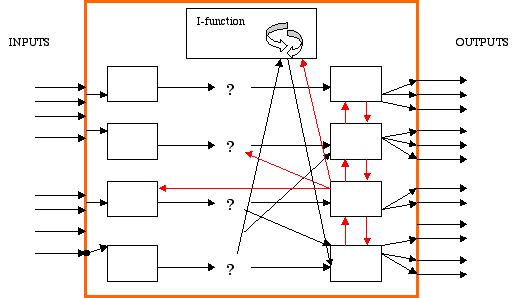 |
Can account in terms of neurons for
Have still to account for
|
Have some useful "boxes"/concepts from thinking about output side in terms of possible origins of motor symphonies ... and some new questions
Output affects input ... input affects output?
Let's reinstate reafferent loop, see what new things that gets us
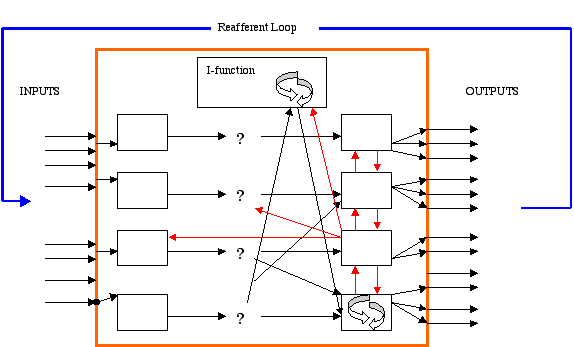
Stretch "reflex"
Not an input-output pathway but a feedback loop
Have motor symphony, central pattern generation, corollary discharge, "purpose", "choice" without I-function
What more from motor side?
Many more boxes/tracts relevant to output side of nervous system (alternate)
Cerebellum, basal ganglia as "loops"
|
The body probably has a "master pattern generator"for movement but not for walking, running, leaping, skipping, etc. It just wouldn't be possible and even if it was, it wouldn't make sense or be as effective/efficient ... Rachel (see figure)
Isn't it possible that it's the very lack of input that causes the nervous system to begin generating patterns on its own? I think it's entirely possible that external input may inhibit these patterns from occurring. Patterns that start in the middle of the box, then, may be possible, but could not actually occur in natural living systems ... Andrea The main question is, can a baby/young child not specify movement because the pattern generator is not well developed or is it that the baby/young child cannot coordinate its movements enough to specify, for example, the movement of one digit? Also, can coordination and pattern generating be similar in origin? Is ones ability to fractionate movement just a series of coordinated pattern generating events? ... Danielle We know that in order for an action potential to be generated, a certain threshold must be met in terms of ion concentration differences. Could it be that along some pattern generation pathways, the threshold is lower and so that pattern is more likely to occur? If so, could it be that in certain situations (e.g. falling off the couch) that the difference between thresholds is large enough that a particular pattern easily "wins out" over the others, but in other situations the difference is not so large and so we're stuck is stuck until the I-function can make a decision? ... Brittany (see also Bethany) I found it intriguing that the body's set point is something that cannot be changed permanently by the I-function but rather, only over a long period of time by the body. If the I-function only changes the set point temporarily, how does it then change for good with only the addition of time? What does time do that the I-function cannot? ... It's disconserting for me to think about weight in this way because although the set point theory makes sense, it is hard to accept that our set points are permanent and not really influenced by our I-function as much as we are usually taught to believe. ... Rachel (see also Nicky) So if we don't have a lot of control over our bodies, our brain's start random signals on their own, and the I function has such a limited scope, why is consciousness such a big part of daily life? While it is what "we" can perceive, it seems the critical feature that defines humans. If you were to damage the I Function, then the body becomes a headless chicken. Why would evolution favour such a system that seems so dependent on such an unstable variable? Could anyone function without an I Function? ... Caroline seems to be implying the body can "function"without the I function. It is just the connections between the "I function"and other parts of the nervous system that allows us to "control"our bodily movements ... this leads me to the question of what death really means ... if all major parts were disassociated from the others would we be "dead"or because our body is sill generating random action potentials are we alive? ... is it universal that the heart beat defines life or death and should we revise this thought based on what we are now learning about the nervous system? ... Whitney Looking back on what we have learned about the nervous system, I am pretty impressed with how much we have accounted for in just looking at the output side and reafferent loop, but ... in the field of Alzheimer's disease, we can correlate the loss of memory with a damaged cortex. But what about those-like me- who suffer from the occasional absentmindedness? How can we account for this? Sometimes when I forget something, I usually need an "input" to jog my memory again. Usually a word, sight, or smell would stimulate my memory. Why is that? The pattern of action potentials has always been there - correct? (at least it has been there since the memory was made) Why is it that sometimes we aren't able to call upon a memory when we want to? Is it a glitch in the system? Similarly, why are some memories more readily called upon than others? ... Jen endurance athletes are able to beat the brain and continue in their events because "they just shift their brain dynamics and alter their perception of reality so the pain matters less. It 's basically a purposeful halluncination." I was wondering where this ability to "shift their brain dynamics" comes from? Is it in the I-function? ... Brom (see also "an experience that cannot be traced back to the empirical world or inputs" ...Scott). Our discussions last week about the nature of reafferent loops and negative feedback loops made me think more about how much of what we humans do isn't really based on conscious decision-making ... Perhaps when we are asleep a box inside our brains outside the I-Function identifies a few of the biggest problems that the conscious mind had been pondering while it was awake the previous day. Then that box sets in motion a reafferent loop that proposes different solutions to the problem until it seems like it has reached a good one. Once it reaches a good solution maybe another reafferent loop is set in motion to solve the next problem. Then when we wake up, a couple of these good ideas that the reafferent loops solved are "presented" to our I-Functions, which is that lightbulb we get in the shower ... Andrew (see also "the I function isn't involved with the behind the scenes work ..." Astra) |
 |  |
Lessons learned "from the output side":
Expectations of what will be learned "from the input side"?
Recall "labelled line" - see lightening, hear thunder because different neurons activated, send action potentials to different places
Vision as a paradigmatic case (is it? ... is at least best studied, and shows some general principals)
"Imaging" - essential role of non-neural structures
Picture on retina and picture in head very different
|
The discussion we had in class as well as those in the forum on life and death were very interesting ... Fatu; Even though we're putting the topic aside for a while, I think that the death discussion comes at a perfect time in the course ... Rebecca et many al. (see Biology 103 and to come in this course) A Depression Switch: Could D.B.S. be the new prozac in 20 years? ... Ebony; It is weird to think of depression as something that can be controlled so locally and not as a pervasive and elusive concept ... Nicky (see also Emily L) Living on Impulse: I found it interesting (though in hindsight not too surprising) that different people have different propensities towards impulses, and that the very idea of an impulse can be divided into smaller categories of behaviors. It also made good sense to me that the behavior of acting on impulses is an amalgorithm of both genes, physical structures, and environmental factors ... Astra
This eye stuff is very interesting, and a little trippy- I keep looking around at everything and trying to figure out exactly what/why/how/if I'm seeing, and thinking all these deep thoughts ... the genetic basis of cataracts ... It made me think of my mom's family, and how she and her two siblings each had to get glasses at the same age. All of this leads me to believe that genes play a big role in the structure of our eyes and in how they change over time ... Brittany If scientists did give someone eyes in the back of their head, would the brain be able to perceive a 360 degree view? Pause and think about what it would look like ... Jessica E. (frog, whale) If it were possible to have two fovea structures per eye, then what would that individual see? ... Danielle (Anableps, some birds) Anna reminded me of the topic of hallucinations and I think it's interesting to attribute it to an over active nervous system. If extra neurons are activated in a certain pattern, I imagine they would produce an image that isn't really "there" (what does it mean to "be there", anyway?) Hallucinations can be chemically induced, like acid trips, and I wonder if those chemicals can make the nervous system overreact ... Suzanne The way I try to understand what we learned in class last week with questions arising in the forum is to think of vision and its relationship to the nervous system as a spectrum. On one extreme end, we can see everything in the physical world the way it is. As we discovered in class during the vision experiments, this doesn"t happen. On the other side of the spectrum, we see nothing in the physical world and hallucinate everything we do "see" in our head. Somewhere in the middle, there is a region of "normal" vision where we basically see most of the physical world as it is processed through our "I" function ... I guess what I am saying is that we always have the potential to hallucinate but as long as our "I" function regulates what is processed by our brain we will essentially see the physical world as it is (with a little exception). But then again, this implies that there is an "overarching control center" for vision ... Jen (see also Erin) I am comfortable with the idea that my brain fills in what it thinks is supposed to be seen. My brain has been doing a lot of this late. I have been having double vision, and when my brain is trying to reconcile what it is seeing, it will choose which image to prioritize. Sometime the I function can even get involved and I can choose which double that my brain will see ... Caroline I'm still not convinced that there are enough photoreceptors to make up the complete visual picture I see. I think that the problem is that I perceive the picture to be a continuum of light, and if it's continuous, isn't that kind of like infinity? And if I see infinitely between these light sources, would there have to be an infinite number of receptors? That was my initial problem, but after the experiment we did in class, I guess that the photoreceptors take in light and the nervous system just "fills in" on a quite large scale so that what I think I see is a continuum of light and color gradients ... Rebecca what is peripheral vision? Is it actually less "peripheral" then we think? If not, then isn't much of it a story about the "picture" that the brain has filled in? Also, if the brain is filling in the information from our peripheral vision, why is it disconcerting when peripheral vision is blocked? ... Carolyn what happens when you see a new complex design, such as a piece abstract art. If you only look at it quickly, in passing, how can your brain fill it in? Or does your eye move that fast, that there isnt actually a "quick glance?" And what if your brain fills it in wrong because it can't tell what was there? Do you then change what you feel it looks like when you really get a good look? ... Marissa Are illusions a product of how light falls on the retina, the processing of the stimulus (light) received, or both? And how will we know? If nothing that we see is real to the extent of how each individual perceives it, then illusions, as a negative pathological construct, is a product of society. Because of how they eye is structured, how it functions and the way light is processed there is no way one individual can dictate to another that what they see is not real. What does that say about science and more interestingly art? ... Whitney
Paul said that color is a scam. How so? ... Brooks People with visual agnosia are not blind; they can distinguish light from dark and they can discriminate basic shapes. Does this disorder explain why the picture on the retina is different than the picture in your head? ... Rachel F. The way the system operates depends on the interactions between different pattern generating circuits rather than the guidance of one overall power center (not even the I-Function would count as a master control, since so many behaviors take place without its guidance). This organization of the brain reminds me a lot of a key Buddhist concept called co-arising. Co-arising states that in cycles there is an interplay between the factors involved rather than there always being a strict cause and effect relationship ... Andrew |
Picture on retina and picture in head very different
Look in more detail at retina and interconnections to get more idea of how much picture in head is "made up" ... and why
Thinking about imaging/lateral inhibition/brightness implies:
How to tell less wrong stories (guess well): using multiple perspectives ... to add depth
| Binocular stereopsis resolving conflict | But ... creating ambiguity |
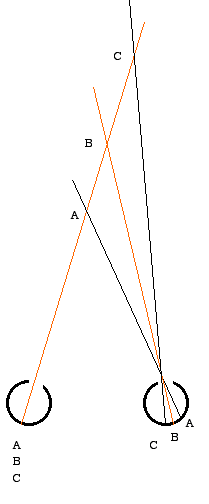 | 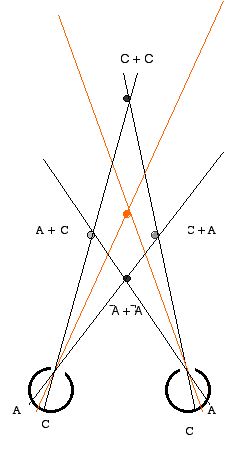 |
Better "picture" by making use of multiple perspectives, accepting/making use of "conflicts"
Ambiguity as fundamental in seeing, sensory systems generally
Can be reduced by using multiple cues, not eliminated (a "useful" gap?)
|
individuals who believe in intelligent design, or wish to discredit evolution for personal or religious reasons often use the example of the eye as proof of their own ideas--how could something as complex as the eye be made in any other way than by the hand of an intelligent creator?
after class this week, i'm not so convinced that this argument holds that much water. i mean, the eye is not a particularly elegant creation, it would seem to me. there are many places where it can go wrong and does ... Em
While (as we said) adult frogs have eyes on the top of their head, tadpoles have one eye on each side of their head. As they grow, not only must the eyes migrate to a new location, but the brain must learn to interpret a totally different picture of the world to still comprehend what is around it ... Marissa (Hoskins and Grobstein, 1985) Maybe Paul can explain what the line from this abstract means: "The putative function of the vestibulo-ocular reflex during a gaze saccade is to adjust the movement of the eye for the movement of the head by adding the saccadic command and the vestibular signal." ... Brooks If there are particular structures in the brain that “fill in” a picture, what happens if we have no genetic basis or previous experiences with the picture being filled in? ... Danielle What affects what we see in a glimpse? For example, does our state of mind influence the picture we see? If there is a negative image, are we more likely to see it if we are in a bad mood? Or are our brains more likely to see one image over another one regardless of emotional influence or experience? ... Stephanie Perhaps since I wore my glasses today, I had a headache because of that, or maybe it had something to do with the visual strain of the illusions. Or, are headaches a manifestation of some sort of difference between the anticipated input and actual input, much like motion sickness? ... Claude The thing that I'm most interested in here is the choice that the brain is making about which image to see. I could only see the skull, and could only see the woman when Prof. Grobstein walked me through it. From what I understand of the nervous system, my brain is perfectly capable of seeing the woman, and indeed my brain must to have seen it in the first place, but for some reason something happened so that the only story I got was of a skull. Clearly there's flexibility, but why don't I see them both at once? Is there truly a choice going on? How does it involve the I function? ... Rebecca the ever-so-clever animation with the flying dog going through a box: why does it take a noticible time for our vision to "change the story"? It is very disconcerting to see it change without my I-function telling it to, and not be able to change back with my I-function telling it to. Why is it so hard to do that? For example, once an illusion is seen/seen to be something else, why is it is difficult to see the illusion again? Like seeing a face in a tree and then determining that it was only a patter of leaves and never being able to see the face again? ... Tamara even if a person knows that the light conditions in a room are going to change rapidly (i.e. turning on a lamp) you cannot make your pupils contract in advance to prepare for the change that you know is coming… Who is in control of the brain? ... Carolyn Now that we've been talking about the I-function, I now have a name for what I was fighting against when I drew. Your "I-function" has an image of what a foot or a nose looks like but you can't listen to it when you draw. You have to solely go on what you're perceiving at that specific time and bypass your I-function (if you're going for a realistic picture that is) ... Drawing seems like one of the most powerful examples of consciously battling our I-function that I've encountered ... Gray my mother and stepfather were about to be married. My Mom couldn't pick between two dresses that were very similar except that one was ivory and one was off-white. When she related this story to my stepfather, he could not have been more perplexed. "There's a difference?!" was more or less what he said. I also remember trying to explain the difference between two areas of color in a sunset to one of my guy friends. "That's magenta, and that's mauve." "I have no idea what you're talking about," he said, even though to me the difference was definitely there ... this made me think that maybe there is some sort of genetic difference ... Or maybe it's just society telling guys it's too girly to notice those little differences and I'm off on a wild goose chase ... Brittany Why did we develop into organisms that see multiple colors opposed to others that don't (i.e. dogs are dichromats)? ... Ebony. (Related: isn't that also why the sensory cells in the retina are located "backwards" to the confuguration we would assume? ... Astra, "modern medicine is merely a codification of folk practice." True or False? ... Julia; see Science as Story Telling and Story Revision) |
This is not yellow |
or
Is color an aspect of physical "reality" or "made up" by the nervous system?
Physical "reality"
Lessons:
|
I found it really interesting that when the class looked at the optical illusions, everyone saw only one of two things or maybe both things at the same time, but no body reported seeing an orange instead of the skull for example. I am still intrigued by how that is possible since neither picture actually exists. It is solely an optical illusion, yet we all see one of the two same pictures in our heads ... Anna
I find it fascinating that even after talking about perception in both this class and my psychology class, I am still making the same mistakes. Often, even knowing what the illusion is and why you percieve it that way, you still can't correctly percieve the picture ... Marissa I'm having a really hard time swallowing the idea that color isn't real ... Andrea I visited the link Julia posted to the test on color blindness and seem to have normal color vision. One interesting thing I noticed was that in the last picture, I definitely saw the "normal" number, but I couldn't make my eyes see what a red-green color blind person would see. In the visual illusions, like the lady in the skull, I could concentrate and switch back and forth between interpretations, but with this color test I couldn't. Is it because, according to what my nervous system says, there is only one possible answer for this test, but the illusions had more than one option? ... Suzanne I also followed that link to the color blindness test, and I also seem to be "normal," at least until I got to the last one- then I seem to be in the opposite situation of Suzanne, where I can see the color blind number, but not the "normal number." - But I saw all the previous normal numbers! And I can kind of guess as to where I think the normal number is, but I'm not sure if I'm right or not. Could this mean that there is perhaps more than one right answer? ... Amber we haven't discussed why certain colors are associated with emotions, for instance red is associated with anger, are these associations strictly the result of culture, or does the perception of certain colors physically trigger other parts of the brain resulting in the feeling of a certain emotion? Would the emotional feeling be as strong in a person who does not perceive color like most of the population? ... Brom I thought that the dark adaptation/movie theater experiment was rather interesting because of what it said about the I function. We've all been in that situation before and for most of us, I would imagine that there was no "Aha!" moment where we were suddenly aware that we were seeing light but not color. However, when the subject in the expeiment was forced to report the colors over and over, there was an "Aha!" moment where the color suddenly disappeared. Does this mean that the rest of the nervous system can push information into the I-function? Come to think of it, isn't that perhaps the basis of talk therapy? ... Rebecca What I found very interesting is the way the brain settles disagreements between the two eyes by creating one view that satisfies both. It makes me wonder what other disagreements go on between the other senses and what the brain is doing to compensate for it. This further shows me that in some way I can choose what I see and smell. As I was looking at the word and picture illusions in class I noticed I made choices in my brain to see what image I wanted to see. I chose to understand an input (the picture) in a way that would be more understandable and acceptable for me. This also brings me back to one of my childhood memories of being able to scare myself by simply looking in the mirror. My visual input was the same as all the other times I looked in the mirror but the processing of that input is what made all the difference in my understanding ... Whitney Since people literally do see things differently and there is no right way to see them, we should also be appreciate of people who express different views than our own since they may ... help us form a new story that will bring us closer to understanding a truth about reality ... Andrew |
Reality always an hypothesis, checked and rechecked ... ?
Where IS "picture in head"? ... where/what is I-function?
Multiple ganglion cell types - more - multiple samples
Retinal projections ... another ... another
Moving on to neocortex
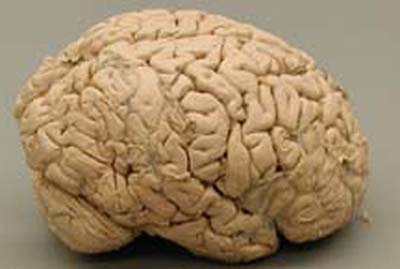 |
 |
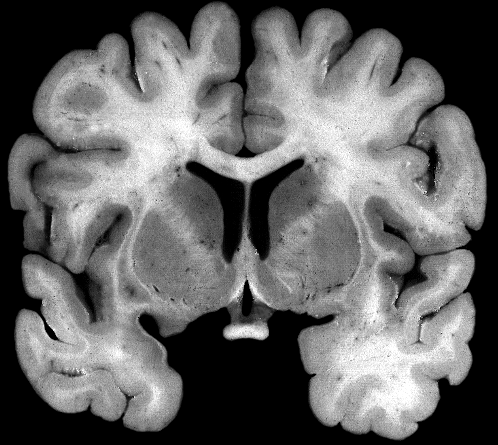 http://www9.biostr.washington.edu/DA-ATLASES/Neuroanatomy/gifs/Forebrain/Coronal%20Slabs/f60eb.gif | 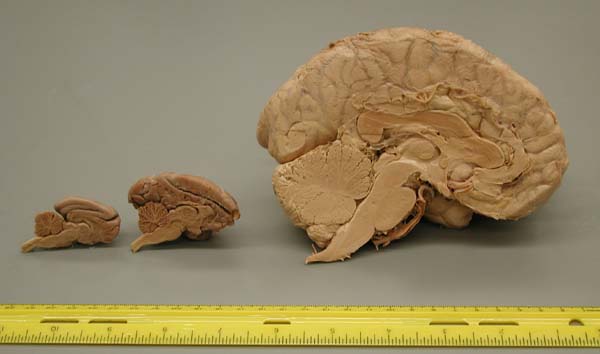 |
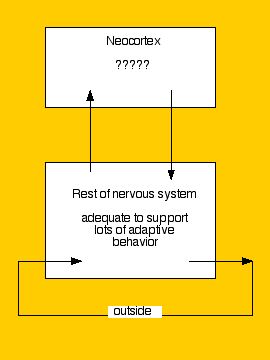 Visual Cortex - binocular convergence, altered "feature" detection, columnar organization, topographic organization
Visual Cortex - binocular convergence, altered "feature" detection, columnar organization, topographic organization
Blindsight and its implications - Don't NEED "picture in head"
 Lessons from sensory side ...
Lessons from sensory side ...

Emotion, feeling, personality, self?
"generalized control mechanisms"
|
I was wondering about our discussion the other week about how color is actually just a projection or mental mapping onto the real world, and in that way it does not exist even though the differentiations it makes are based on the wave frequencies that the retinal nerves are perceiving. This led me to wonder about the concept of harmony, and whether it is a similar human projection ... Scott
I particularly liked the discussion of the notion of reality ... At the beginning of the semester, I made a post about history being a series of hypotheses being tested, and I think that can apply here as well. If you have a hypothesis on how things should be done (e.g. we should have a democracy, we should form a rebellion, we should pass such-and-such a bill), this is based on your idea of reality. If you can find enough people that agree with that perception of reality and/or the need to change it, you can bring about that change ... Brittany They developed a electromagnetic machine that enables them to temporarily blind volunteers while performing a number of visual tests. They found that those who were more certain in their answers were more accurate as well ... Jen
why do we have recurring dreams? Are they a form of "unfinished business" in our subconscious? What is so special about recurring dreams that makes our brains think of the same scenario time and time again instead of making up a new one? ... Stephanie Why doesn't dream interpretation work for me? Why do some people firmly believe in it? ... Emily L I wonder why the I-function "feels the need" to make a somewhat coherent story out of the neuronal firing? ... Gray With no I-function in dreams the justifications and rationalizations we create to explain our actions and attitudes are stripped away. In this sense the feelings and thoughts in dreams may represent a more accurate or "true" sense of our souls, if one believes in such things, than our waking behavior. Perhaps dreams are the purest expression of our being... Brom
During sleep the body enters a flaccid state but what happens to those people who "sleep walk" and engage in extensive conversations with those around them, are they considered to be sleeping? ... Danielle I've always been under the impression that paralysis only occurs during REM sleep ... Andrea It seems to me like all sleepwalkers would be dead because they fell down the stairs or something... Carolyn My roommate sleep walks quite frequently, which can be entertaining for me. Usually she gets up after sleeping only for a short time, so it is hard to tell if she is awake or not. I carry on conversations with her and see how she responds ... Nicky I sleepwalk, talk, and give directions. My roommate last year eventually stopped telling me when I talked to her - I never remembered a thing. Sometimes I do things like get up and wander about the room, or carry on a meaningless conversation. But other times i engage in rather complex behavior: I've given someone directions to another city, I've lend someone my sharpener - and spend a good 5 minutes looking for it by my roommates account. I have no memory of either of these events. How would we integrate what I feel are complex processes with the idea that sleepwalking is all automatic machinery. Maybe my case is reinforcing the idea that there are several levels to concious and unconcious behavior - there are more layers than reflex and i-function ... Astra
his I-function was clearly doing something that wasn't matching up with reality at the same time that he was recieving sensory input. Could it be that the sensory perception gets "turned on" while the connection between input and the I-function that allows you to double check stories is still asleep? Or does something else happen with anesthesia? ... Erin people who happen to sleep less in general lose decision-making ability, which is an important part of personality. This is strong evidence that personality is something that changes in different situations and under different conditions rather than something that remains static in all but the most drastic life or death situations ... Andrew |
Other generalized control mechanisms ...
Personality - aspects of behavior/internal experience that are relatively resistant to change either environmentally or by I-function?
Self - distributed - ongoing dynamic interplay of unconscious and story-teller?
 |
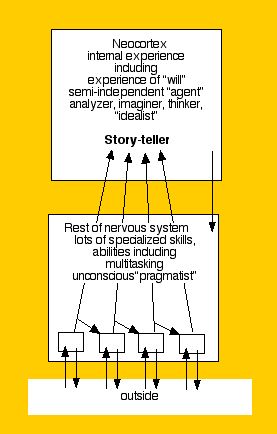 |
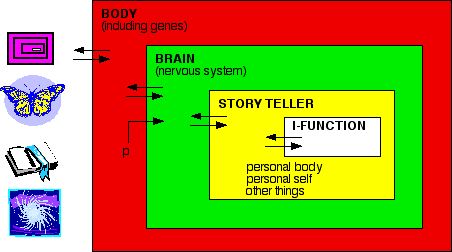 "Reality" a story (like picture in head), made up of feelings, intuitions from unconscious, thoughts, hence potentially conflicting and revisable, by among other things personal choice
"Reality" a story (like picture in head), made up of feelings, intuitions from unconscious, thoughts, hence potentially conflicting and revisable, by among other things personal choice
Dickinson -
Good story? Bipartite brain gives us not only capacity to affect ourselves but makes us interacting agents in a world that we are both influenced by and can influence ... by our stories
Abandoning dualism, rewriting Descartes:

|
The Brain - is wider than the Sky - For - put them side by side - The one the other will contain With ease - and You - beside-
| 
|
|
Trust where you are at any given time, both your similarities to and your differences from other people, both your coherences and your conflicts Learn, to get "less wrong" Explore, to see what else there might be Dream, to conceive what hasn't yet been Share stories Choose Remake yourself, and the world
And repeat, over and over and over again
| 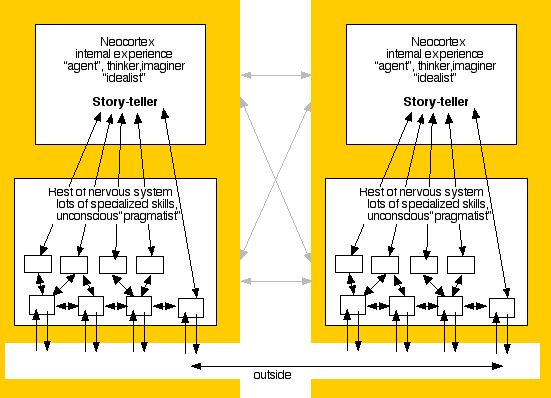
|
|
|
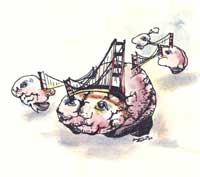 Leave your reflections on your own "getting it less wrong" this semester in the forum area
Leave your reflections on your own "getting it less wrong" this semester in the forum area
Keep me posted on your exploring
Happy to have collaborators
To be continued
| Course Home Page
| Course Forum | Brain and
Behavior | Serendip Home |
![]()
© by Serendip 1994-
- Last Modified:
Wednesday, 02-May-2018 10:53:10 CDT